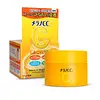What's inside
What's inside
 Key Ingredients
Key Ingredients

 Benefits
Benefits

 Concerns
Concerns

 Ingredients Side-by-side
Ingredients Side-by-side

Ascorbyl Glucoside
AntioxidantTocopheryl Acetate
AntioxidantDipotassium Glycyrrhizate
HumectantAscorbic Acid
AntioxidantAlpinia Katsumadai Seed Extract
Skin ConditioningCitrus Limon Fruit Extract
MaskingCornus Officinalis Fruit Extract
Skin ConditioningC4-18 Alkyl Methacrylate/Methacryloyloxyethyl Phosphorylcholine Copolymer
HumectantButylene Glycol
HumectantPentylene Glycol
Skin ConditioningGlycerin
HumectantBifida Polysaccharide
HumectantPentaerythrityl Tetraethylhexanoate
EmollientPPG-17 Butyl Ether
Skin ConditioningPotassium Hydroxide
BufferingPolyvinylalcohol Crosspolymer
Diethoxyethyl Succinate
SolventPEG-8 Dimethicone
EmulsifyingPolyglyceryl-2 Hydroxypropyl Ethylhexyl Ether
CleansingPolyacrylamide
Phenoxyethanol
PreservativeGlyceryl Hydroxystearate
EmollientParaffinum Liquidum
EmollientPEG-20 Sorbitan Isostearate
EmulsifyingSodium Paraben
PreservativeBehenyl Alcohol
EmollientCetearyl Alcohol
EmollientPPG-4 Lauryl Ether
EmollientXanthan Gum
EmulsifyingC16-24 Alkyl C16-24 Acidate
Skin ConditioningAcrylates/C5-8 Alkyl Acrylate Copolymer
Emulsion StabilisingParfum
MaskingAscorbyl Glucoside, Tocopheryl Acetate, Dipotassium Glycyrrhizate, Ascorbic Acid, Alpinia Katsumadai Seed Extract, Citrus Limon Fruit Extract, Cornus Officinalis Fruit Extract, C4-18 Alkyl Methacrylate/Methacryloyloxyethyl Phosphorylcholine Copolymer, Butylene Glycol, Pentylene Glycol, Glycerin, Bifida Polysaccharide, Pentaerythrityl Tetraethylhexanoate, PPG-17 Butyl Ether, Potassium Hydroxide, Polyvinylalcohol Crosspolymer, Diethoxyethyl Succinate, PEG-8 Dimethicone, Polyglyceryl-2 Hydroxypropyl Ethylhexyl Ether, Polyacrylamide, Phenoxyethanol, Glyceryl Hydroxystearate, Paraffinum Liquidum, PEG-20 Sorbitan Isostearate, Sodium Paraben, Behenyl Alcohol, Cetearyl Alcohol, PPG-4 Lauryl Ether, Xanthan Gum, C16-24 Alkyl C16-24 Acidate, Acrylates/C5-8 Alkyl Acrylate Copolymer, Parfum
Ascorbic Acid
AntioxidantPyridoxine Hcl
Skin ConditioningAllantoin
Skin ConditioningO-Cymen-5-Ol
Antimicrobial3-O-Ethyl Ascorbic Acid
Skin ConditioningAscorbyl Glucoside
AntioxidantAscorbyl Tetraisopalmitate
AntioxidantTocopherol
AntioxidantAlpinia Katsumadai Seed Extract
Skin ConditioningCitrus Limon Leaf Extract
PerfumingCitrus Grandis Leaf Extract
AstringentSerine
MaskingButylene Glycol
HumectantPropanediol
SolventIsopentyldiol
HumectantPropylene Glycol
HumectantPEG-8
HumectantAlcohol
AntimicrobialPolyglyceryl-3 Decyltetradecyl Ether
EmulsifyingSodium Metabisulfite
AntioxidantEDTA
Parfum
MaskingAscorbic Acid, Pyridoxine Hcl, Allantoin, O-Cymen-5-Ol, 3-O-Ethyl Ascorbic Acid, Ascorbyl Glucoside, Ascorbyl Tetraisopalmitate, Tocopherol, Alpinia Katsumadai Seed Extract, Citrus Limon Leaf Extract, Citrus Grandis Leaf Extract, Serine, Butylene Glycol, Propanediol, Isopentyldiol, Propylene Glycol, PEG-8, Alcohol, Polyglyceryl-3 Decyltetradecyl Ether, Sodium Metabisulfite, EDTA, Parfum
 Reviews
Reviews

Alternatives
Ingredients Explained
These ingredients are found in both products.
Ingredients higher up in an ingredient list are typically present in a larger amount.
We don't have a description for Alpinia Katsumadai Seed Extract yet.
Ascorbic Acid is is pure Vitamin C. This form makes up the largest amount of vitamin C found naturally in our skin.
Not only is vitamin C great for your overall health and immune system, it also has plenty of benefits on your skin.
Vitamin C is best used for brightening skin. It improves dark spots, acne scars, and hyperpigmentation. This is because it blocks the process of skin darkening when exposed to UV.
Remember: Vitamin C should not replace sunscreen!
Your skin uses vitamin C to build collagen. Collagen is one key component in having a strong skin barrier and plump skin. Vitamin C also plays a role in regulating collagen, thus making it effective in improving wrinkles and fine lines.
Ascorbic acid shows potent antioxidant activity. As an antioxidant, it helps fight free-radicals. Free-radicals are molecules that may damage your skin cells. These antioxidants also protect skin against UV damage.
The best formulations include Vitamin E and/or ferulic acid. These two ingredients help stabilize and provide a boost in the benefits of ascorbic acid. This is because ascorbic acid becomes unstable when exposed to UV and air. In fact, you can tell your ascorbic acid has oxidized when it turns an orange-yellow color.
Ascorbic acid is generally compatible with other ingredients. However, using ascorbic acid with other active ingredients might cause irritation. Two ingredients: copper ions and benzoyl peroxide, will inactivate ascorbic acid completely.
Read more about other types of Vitamin C:
Foods rich with vitamin C include oranges, strawberries, broccoli, bell peppers, and more. When consuming Vitamin C, your skin receives a portion of the nutrients.
Learn more about Ascorbic AcidAscorbyl Glucoside is a stable form of Vitamin C. It is created by combining glucose from starch.
When applied to skin, Ascorbyl Glucoside turns into Ascorbic Acid.
Ascorbyl Glucoside is an antioxidant. Antioxidants help fight free-radicals, or molecules that may damage skin cells.
It can help to reduce redness, improve skin texture, reduce the effects of aging, reduce the visibility of dark spots, and brighten skin.
Read more about other types of Vitamin C:
Learn more about Ascorbyl GlucosideButylene Glycol (or BG) is used within cosmetic products for a few different reasons:
Overall, Butylene Glycol is a safe and well-rounded ingredient that works well with other ingredients.
Though this ingredient works well with most skin types, some people with sensitive skin may experience a reaction such as allergic rashes, closed comedones, or itchiness.
Learn more about Butylene GlycolParfum is a catch-all term for an ingredient or more that is used to give a scent to products.
Also called "fragrance", this ingredient can be a blend of hundreds of chemicals or plant oils. This means every product with "fragrance" or "parfum" in the ingredients list is a different mixture.
For instance, Habanolide is a proprietary trade name for a specific aroma chemical. When used as a fragrance ingredient in cosmetics, most aroma chemicals fall under the broad labeling category of “FRAGRANCE” or “PARFUM” according to EU and US regulations.
The term 'parfum' or 'fragrance' is not regulated in many countries. In many cases, it is up to the brand to define this term.
For instance, many brands choose to label themselves as "fragrance-free" because they are not using synthetic fragrances. However, their products may still contain ingredients such as essential oils that are considered a fragrance by INCI standards.
One example is Calendula flower extract. Calendula is an essential oil that still imparts a scent or 'fragrance'.
Depending on the blend, the ingredients in the mixture can cause allergies and sensitivities on the skin. Some ingredients that are known EU allergens include linalool and citronellol.
Parfum can also be used to mask or cover an unpleasant scent.
The bottom line is: not all fragrances/parfum/ingredients are created equally. If you are worried about fragrances, we recommend taking a closer look at an ingredient. And of course, we always recommend speaking with a professional.
Learn more about Parfum